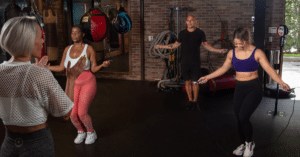
The Benefits of Jump Rope Training in Boxing
Boxing is not just about throwing punches, it is a sport that requires proper footwork, timing, and quickness. One of the best

If your boxing exercise does not include a core workout, you aren’t doing it right.
Engaging your trunk muscles is fundamental to proper boxing technique and fitness exercises in general. Besides sculpting out chiseled abs, a core workout increases strength around the midline and helps you exercise with better form, balance and stability.
Obviously, core engagement while exercising is crucial. Gym instructors all over the country seem to agree on this one, and you’ve likely heard variations of this slogan a million and one times at gyms and fitness classes:
But how exactly, you ask? Let’s start with Core Anatomy 101.
Your core is not just abs and lats, it actually consists of over 20 muscles and muscle groups in your midsection. Of these, five groups are most prominent:
Like the lats, they’re back muscles, but often not as large. They also straighten the back and aid side-to-side motion.
The TVA muscle is essential to diaphragm motion during breathing.
Besides the abs and back muscles, engaging the core also requires contraction of glutes and hip flexors. The fact that all these muscles must be involved makes engaging your core seem highly complicated. Yet, like any other fitness training technique, it can be mastered.
You may think boxing is all about having chiseled arms. But that’s less than half the story. Having a stronger core helps provide both the stability needed to maintain a defensive position and the power to deliver solid punches
It doesn’t end there. When you engage your core during fitness boxing, you reduce the chances of sustaining injuries from your workout. Core engagement also helps you exercise with better form, and may even alleviate chronic back pain.
Most fitness exercises put a strain on your backbone, and racks up the chances of injury to spinal discs. There is a horrifyingly large variety of spinal defects that can possibly arise: including lumbar spondylosis. However, these risks can be minimized by engaging your core while exercising.
Bracing the muscles in your midsection keeps you from overextending your vertebrae and prevents injury to the shoulders and elbows. It also does not allow for over twisting, which can be dangerous. Safety is key in a workout, and core engagement allows you to exercise safely.
Olympic weightlifters typically brace their core to deadlift those massive barbells. For fitness boxers, a stronger core offers more endurance for performing different kinds of boxing exercise without expending too much energy.
This improved performance might have something to do with reduced pain levels. Even pros tend to reduce the intensity of a workout once it gets painful. However, working out with an engaged core minimizes muscle pain, which helps you exercise longer with excellent form.
Core engagement also enhances actual boxing performance. Many core muscles run from the pelvic girdle to the chest, providing that vital link that transfers explosive power from the legs to the fists. The evidence shows that a harder core produces a stronger punch.
In a core workout, you contract the muscles around your midline, while maintaining normal breathing. In fact, all of core engagement can be summarized by muscle contraction and consistent breathing.
Pretty simple, right? Well, to begin with, three types of muscle contractions occur when engaging your core during a boxing exercise:
Core workouts require that all of these types of contractions occur while breathing freely. Obviously this cannot occur if your stomach is ‘sucked in’; that halts your breath and leaves you gasping for air. Natural breathing is particularly important as it is what makes the core muscles tense up like a sheath around the spine.
To create this effect, first inhale deeply to fill your belly with air. With your abdomen tightened, continue to breathe while ensuring only your rib cage is moving. Now perform any drill from your workout routine, preferably a boxing exercise. This is core engagement.
When you lift weights, there are numerous chances for spinal movement – arching your back, bending your shoulders, hips, knees and ankles. It is most crucial to engage your core during weight lifting to prevent hyperextension of the spine and allow you to lift better.
During the deadlift, for example, take a deep breath as you contract your core muscles to maintain a vertical posture while raising the bar bell. This lets you keep your shoulder blades retracted and your back as straight as possible during the exercise.
During crunches, or russian twists, watch for signs that you need to engage your core. The most common sign is excessive flexing of the back, or hyperextension. For planks though, you need to engage your core throughout the duration of the isometric hold.
In an ab workout, squeezing your glutes and tipping your tailbone forward can help with stabilization and core engagement. Minimizing the lumbar curvature of your spine also makes you workout with better form.
Although cardio exercises are not considered core workouts by a long shot, engaging your core during cardio helps with posture and endurance. Aches and pains from prolonged cardio are also reduced when you exercise while bracing your trunk muscles.
Boxing is essentially a cardiovascular activity. It requires good physical conditioning as well as stamina, agility and strength. When you start to incorporate a core workout into your boxing exercise routine, you tap into a larger fitness potential in these areas.
At Delray Boxing Club, we instruct you on how to engage your core muscles to box like a pro. Thinking of signing up?

Boxing is not just about throwing punches, it is a sport that requires proper footwork, timing, and quickness. One of the best

Boxing is a great way to get fit and stay in shape. It has been around for centuries, and yet it is

Are you looking to get into the exciting world of boxing? Choosing the right boxing gym is essential to achieving your goals,

Boxing is not just about throwing punches, it is a sport that requires proper footwork, timing, and quickness. One of the best ways to enhance

Boxing is a great way to get fit and stay in shape. It has been around for centuries, and yet it is still one of

Are you looking to get into the exciting world of boxing? Choosing the right boxing gym is essential to achieving your goals, whether it’s to
Considering membership? Give us your email and we’ll send you a voucher for a complimentary class. The first one is on the house!